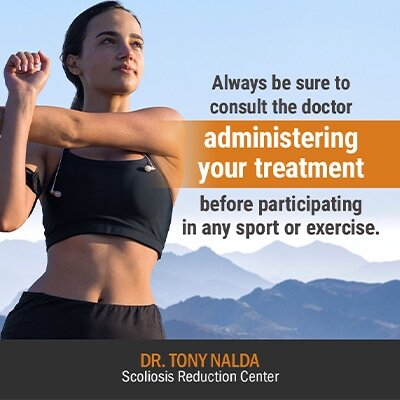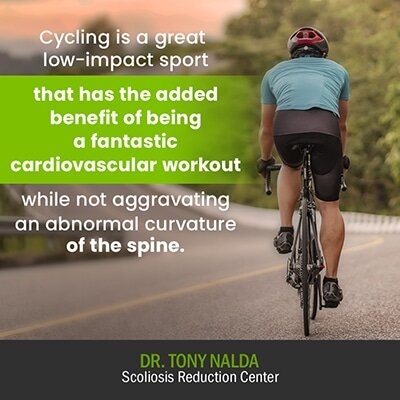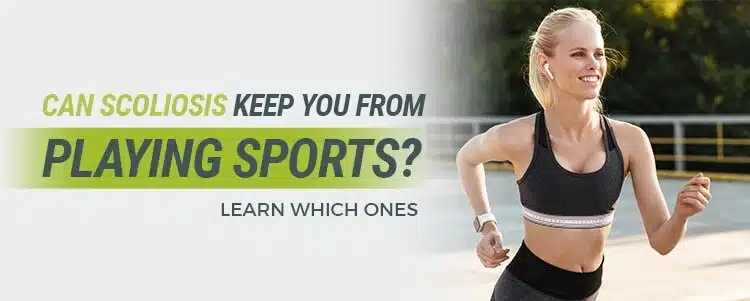While some sports only need to be tweaked to become more scoliosis-friendly, others can exacerbate the condition; these would include sports that overuse one side of the body, or are high-impact. In general, however, appropriate sports/ exercise are very beneficial in terms of treatment efficacy and overall health.
Before we move on to exploring which specific sports are deemed scoliosis-friendly and which ones to avoid, let’s discuss why staying active before, during, and after treatment is so beneficial.
Scoliosis Treatment and Overall Health
We have all heard about, and likely experienced, the benefits of a healthy diet and lifestyle. For people facing a medical condition or disease, these benefits can be amplified.
Patients that come into the Scoliosis Reduction Center® for treatment and are already living a healthy and active lifestyle are the ideal patients to work with. Generally, they have better mental health and a more positive attitude about facing the challenge of treatment and living with their condition.
The endorphins that bodies are flooded with during exercise are natural mood elevators, and obviously, being diagnosed with any incurable and progressive condition can really test a person’s psychological resilience.
Facing any challenge with a healthy mindset can have a lot of benefits when it comes to the mental and physical challenges of treatment. Having the mental capacity to not give up and push through the hard stuff is an important component of treatment success.
Being in better physical shape when starting treatment is beneficial for obvious reasons: if the body is already at a certain fitness level, it’s that much better equipped to deal with the rigors of treatment and its duration.

Patients who are already used to living a healthy and active lifestyle are also better able to sustain treatment results in the future as at-home exercises and dedication are necessary.
Another important thing to remember is that every condition is different and needs a customized treatment approach, so what might be safe for one person could be harmful for another. Always be sure to consult the doctor administering your treatment before participating in any sport or exercise.
Sports and Mental Health
When we consider the main form of scoliosis, adolescent idiopathic scoliosis, let’s take a minute to look at how sports can affect this age group generally, and not just for those with scoliosis.
Sports can be hugely beneficial for adolescents, in terms of mental health, physical health, keeping them on a positive path, and away from the temptation of unhealthy activities.
For adolescents with scoliosis, again, these benefits are amplified. We know that adolescence is a tumultuous time filled with uncertainty; imagine the challenge of being diagnosed with a life-long medical condition while already riding the waves of pubescent hormones, the pressures of social media, and the struggle to fit in and discover who you are.
At this and every stage of life, I don’t want my patients to feel that their scoliosis defines them; each and every patient is far more than their condition alone, and having a healthy outlet like sports gives adolescents a healthy identity-touchstone they can return to and take comfort from.
That being said, there are, however, some sports that are not considered scoliosis-friendly, and these might need to be avoided or adjusted accordingly.
Sports and Scoliosis
As scoliosis means there is an abnormal sideways curvature to the spine, we don’t want patients to participate in sports or activities that exaggerate this deformity and the asymmetry that it causes. Sports that work the muscles evenly on both sides of the spine are ideal.
Specifically, sports that promote thoracic extension (flattening of the middle-back area) are not deemed scoliosis-friendly because this is akin to the loss of the spine’s healthy curves caused by scoliosis.
Let’s take a look at some specific sports and why they are, or are not, considered scoliosis-friendly. Let’s start with sports and activities considered beneficial for scoliosis patients.
Swimming
Swimming is often regarded as one of the best activities for those with scoliosis.
Scoliosis is very gravity-driven, and there are only three times in life that we are not subject to gravity: in the womb, in space, and in water.
The weighless effect of water places less impact on the spine and can work to promote healthy spinal discs, not to mention providing relief from discomfort.
In addition, swimming works a variety of muscles in a balanced and symmetrical way, which is ideal for people with scoliosis needing strong and healthy muscles to help support and stabilize the spine.
There are, however, some swimming techniques that can encourage hypertension (flattening of the middle back), but with a little scoliosis awareness, these can easily be avoided and swimming can be continued as a healthy scoliosis-friendly sport/activity.
Running and Walking
Running, walking, and hiking are great activities for people with scoliosis. Another activity that uses the same motion as running and walking is cross-country skiing, and this is also a scoliosis-friendly activity.
Just look to the world’s fastest man, Usain Bolt, to see how scoliosis didn’t slow him down.
That being said, walking and sprinting are more ideal than long-distance running that can involve repeated shocks and compression.

Cycling
Cycling is a great low-impact sport that has the added benefit of being a fantastic cardiovascular workout while not aggravating an abnormal curvature of the spine.
Mountain biking may not be as safe as road cycling due to the high-impact jolting motion that can compress the spine.
Soccer
Soccer is a great scoliosis-friendly sport, and it’s especially good for adolescents with a middle-back curvature.
Soccer strengthens the body’s core muscles, known to support the spine and helps preserve the thoracic spine’s healthy natural curvature; this has the effect of counteracting the flattening of the spine that characterizes thoracic scoliosis.
However, collisions that can occur during a game should be avoided as much as possible to preserve the health of the spine, especially during treatment.
Strength Training
Strength training for people with scoliosis is one of those activities that can be safe, if it is tweaked appropriately.
Building strength is particularly beneficial for people with spinal issues because stronger muscles are more effective at stabilizing and supporting the spine.
There are, however, precautions that have to be taken to ensure the activity is being done safely. A person with scoliosis would want to increase the weight they are lifting very gradually to avoid stressing the spine, which could strain and weaken it.
Certain techniques such as repeatedly lifting weights above the head or squatting should be avoided as this can lead to spinal compression.
As you can see, there are many sports and activities that are not only safe to continue after a scoliosis diagnosis, but that also have specific benefits for people living with scoliosis.
On the flip side of that, there are naturally going to be sports and activities that are not scoliosis-friendly, so let’s take a look at some of these.
Collision Sports: Football, Hockey, and Gymnastics
While collision sports might not have to be entirely prohibited, they should be approached with extreme caution.
Sports such as football, hockey, and gymnastics are more likely to place extra strain on the spine that can result in injury and reduce the effectiveness of treatment.
For adolescents undergoing active treatment, it’s likely best that these activities are avoided, or at the very least modified, to preserve the efficacy of the treatment process.
Asymmetrical Sports: Golf, Bowling, and Tennis
When scoliosis develops, one of the main symptoms is postural changes that cause an overall asymmetry to the body.
Sports that are asymmetrical, meaning they overuse one side of the body, don’t promote even muscle development and strength and exaggerate this effect of scoliosis.
Sports like golf, bowling, and tennis all involve overusing one side of the body, which plays into the uneven forces already at work with scoliosis. Golf, in addition, involves a twisting motion that is not particularly good for the spine and mimics the rotation aspect of scoliosis.
Sports with Repetitive Shocks: Horseback Riding and Long Jump
Sports that involve repetitive shocks are particularly bad for people with scoliosis because they involve repeated jarring motions.
Scoliosis introduces compression to the spine, so sports that increase this factor should be approached with extreme caution.
In addition to sports that are known to be helpful for scoliosis patients, there are also certain exercises that are an important part of our treatment approach, so let’s take a look at some of those.
Scoliosis-Friendly Exercises
As I mentioned, I place a lot of emphasis on the benefits of a healthy and active lifestyle for everyone, and these benefits are amplified for scoliosis patients.
For those who are not particularly into sports, there are many ways to stay active and healthy, and some simple scoliosis-friendly exercises are the way to go and an important aspect of our integrative approach. Let’s focus on four:
Stretches
Stretches done in a symmetrical manner can do a lot for relieving some of the adverse tension that scoliosis introduces to the spine and its surrounding muscles.
Stretches are a healthy noninvasive way to keep the spine and the muscles that surround it as loose as possible.
Some examples of these would be chest and shoulder stretches, side bends, the piriformis stretch, and hip flexion stretches.
Rowing
Rowing, either done by machine, or naturally in a canoe or kayak, can be an amazing exercise for people with scoliosis.
This symmetrical motion works to strengthen the latissimus dorsi muscles.
The Plank
Planking is a great way to increase core strength and improve overall muscle strength. It is a simple exercise that also needs no equipment and can be done anywhere.
If you are planking properly, you will feel its effects in the lower abdominal muscles and the lower back.
CLEAR Institute Back Exercises
I am a CLEAR-certified doctor, and the CLEAR Scoliosis Institute’s list of recommended back exercises for scoliosis patients is a fantastic resource. If you are looking for a more effective and comprehensive exercise program, consulting with a CLEAR-certified doctor directly can be highly beneficial
Their list of exercises can easily be done from home and work toward increasing strength and relieving scoliosis-related discomfort.
Some exercise examples from this list include spinal rotation warm up, spinal molding cool-down therapy, cervical flexion, cervical extension, lumbar extension, and the chest expander.
What Sports Are Good for Scoliosis?
As mentioned, sports that are good for scoliosis are those that help keep the spine strong and flexible, along with the spine’s surrounding muscles; it’s not just the spine that has to maintain its natural curves and alignment, but also the spine’s surrounding muscles.
Sports that are good for scoliosis make the patient healthier, and this helps create an environment inside the body that’s conducive to healing, and let’s not forget the mental health benefits associated with an active lifestyle.
Not only does regular exercise and participating in sports help keep stress at bay, it also helps foster a positive attitude that can be an indispensable part of treatment success.
Scoliosis treatment can be intense, and a patient who has maintained a healthy weight and activity level, is going to be better able to handle the rigors of treatment and stay motivated.
Part of effective scoliosis treatment includes guidance on how to lead a spine-friendly lifestyle, and this will involve recommendations on sports that are good for scoliosis, spots that should be approached with caution, and those that are deemed dangerous for people with scoliosis.
Athletes with Scoliosis
Particularly for my young patient recently diagnosed, the fear of not being able to participate in loved sports can be devastating; for many young adolescents, sports are a huge part of life.
Athletes who have scoliosis can be inspiring for young athletes recently diagnosed and can motivate them not to give up on their dreams and goals.
It can be difficult to explain to young patients that as the condition is progressive, it will never simply go away, not even with treatment success; scoliosis treatment is more about maintaining an ongoing condition.
But while scoliosis is incurable and progressive, it can be highly treatable, particularly with early detection and intervention.
I do like to point out that there are a number of professional athletes and celebrities that still went on to fulfill their life’s goals despite having a scoliosis diagnosis: Usain Bolt, for example.
Usain Bolt is an 8-time Olympic gold medalist who is still considered as the fastest man alive, and then there is Lamar Gant who is a world-record holding powerlifter who was diagnosed with scoliosis as a child.
There are countless athletes and individuals who prove that people have a choice to make when they are diagnosed with scoliosis: to merely survive with the condition, or to thrive despite it.
How Does Scoliosis Affect Athletes?
No two cases of scoliosis will be the same; not only are there different severity levels, there are also a number of different condition types a person can develop, and it’s difficult to predict how a patient’s body will respond to the condition and treatment.
Scoliosis will affect athletes in different ways based on patient age and overall fitness level, condition type, severity, curvature location, and curvature pattern.
In addition, the type of sport an athlete plays is important because as we now know, some sports and activities are deemed safe for people with scoliosis, while others should be approached with caution, and some completely avoided.
Scoliosis affects athletes by having to monitor how they approach a sport and the types of positions it puts the spine in; athletes also have to confirm with their treatment provider that a specific sport and/or activity won’t interfere with treatment or exacerbate the condtiion’s effects.
Usain Bolt, for example, had to work on the mechanics of his stride to counteract the discrepancy in his leg lengths caused by his scoliosis, and who knows, maybe it was his efforts to counteract his spinal deformity that gave him an edge over the competition.
So scoliosis affects athletes by making them particularly mindful of body positioning and spinal biomechanics; it can also affect some athletes who experience activity restrictions, or others who are told they need to adjust how they play a certain sport, and sports that involve repeated collision and stress from impact will likely be restricted.
Snowboarding and Scoliosis
Again, while each case is different, in many cases, snowboarding isn’t helpful for those with scoliosis.
Snowboarding involves holding the body in a certain posture for an extended period of time and ground reaction forces mean compression that occurs from going over bumps and making contact with the ground repeatedly.
Snowboarding is known as hard on the spinal discs because of the bouncing and compressive force of going over jumps, and spinal degeneration can be particularly bad for people with scoliosis.
Snowboarding can cause overuse injuries, increase spinal degeneration, and introduce more spinal compression to an already compressive spinal condition (adult scoliosis).
How to Treat Scoliosis in Sports Medicine
Sports medicine focuses on joint movement, muscle strength, and overuse injuries.
When it comes to treating scoliosis in sports medicine, this involves a comprehensive understanding of the scoliotic spine.
Practitioners have to be aware of the different forces that a scoliotic spine is facing, how to minimize those uneven forces, and how to address any related areas of muscle imbalance.
A key element of sports medicine and scoliosis is maintaining symmetry. Scoliosis introduces a lot of uneven forces to the body, which is why its main visual effect is postural deviation that involves a disruption to the body’s overall symmetry.
Sports medicine has the goal of establishing muscle balance around the spine so it is optimally supported and stabilized by its surrounding muscles.
Scoliotic curves pull the spine’s surrounding muscles in different directions, commonly causing muscles on one side of the spine to become sore and tight from overuse, and muscles on the other side to become weak from underuse.
Sports medicine and physical therapy will work towards restoring muscle balance around the spine as this is counteracting the condition’s asymmetrical effects.
Sports medicine for scoliosis will provide guidance on the type of weight lifting that can be beneficial for people with scoliosis, and will know the types of deadlifts to avoid to protect the spine.
Sports medicine for scoliosis can also help with pain management and preventing spinal degeneration that increases progressive rates in adults.
Conclusion
Life inevitably comes with its share of challenges, and for a person who also has the rigors of a spinal deformity to face, another layer is added.
It’s natural to wonder how much scoliosis will affect the life of a young person recently diagnosed, especially one who is heavily into sports. The good news is that while there are certain sports and activities that should be avoided, many beloved sports can be approached with caution and tweaked as the individual’s condition necessitates.
Part of my goal with writing Scoliosis Hope was to address these concerns and, hopefully, remove some of the negativity surrounding scoliosis by accentuating the fact that a scoliosis diagnosis does not have to be limiting or all-defining.
In addition, there are many sports/activities such as walking, running, soccer, swimming, cycling and rowing that are known to carry scoliosis-related benefits. There are also a number of stretches and exercises that can help strengthen and support the spine.
Overall, sports that should be avoided are those that work muscles of the body unevenly or place excess stress and compressive force on the spine; sports that are considered safe and even helpful are those that work the body symmetrically and increase strength and flexibility.
Regardless of the form of exercise or sports you engage in, if they are scoliosis-friendly and approved by your treatment-provider, staying active throughout treatment and beyond can be hugely beneficial in terms of physical and mental health.





